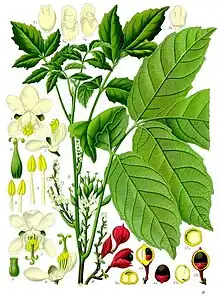| Paullinia | |
|---|---|
 | |
| Paullinia cupana | |
| Scientific classification | |
| Kingdom: | Plantae |
| Clade: | Tracheophytes |
| Clade: | Angiosperms |
| Clade: | Eudicots |
| Clade: | Rosids |
| Order: | Sapindales |
| Family: | Sapindaceae |
| Subfamily: | Sapindoideae |
| Genus: | Paullinia L. |
| Species | |
|
See text | |
| Synonyms[1] | |
|
Semarillaria Ruiz & Pav. | |
Paullinia is a genus of flowering shrubs, small trees and lianas in the soapberry family, Sapindaceae, native to tropical South America, Central America and the Caribbean.
The genus is named after the German medical botanist Christian Franz Paullini, who discovered the genus in the Caribbean in the 18th century.
- Selected species
- Paullinia alata
- Paullinia cupana Kunth - Guaraná (Amazon Basin)
- Paullinia cururu
- Paullinia fuscescens
- Paullinia navicularis Radlk. (Ecuador)
- Paullinia paullinioides
- Paullinia pinnata
- Paullinia plumieri
- Paullinia weinmannifolia
- Paullinia yoco - Yoco
Uses
Several uses are recorded. The fruit of several species are edible, with P. cupana (Guaraná) being the most popular. Other species, notably P. yoco (Yoco), are used as herbal medicine for various treatments. The sap of some species, notably P. cururu is highly toxic, and is used as an arrow poison by Native American tribes in South America. Similarly, the long flexible stems of Paullinia pinnata are used to poison fish in shallow pools, as described by the English naturalist Henry Walter Bates in his book The Naturalist on the River Amazons.[2]
References
- ↑ "Paullinia L." Germplasm Resources Information Network. United States Department of Agriculture. 2006-03-29. Archived from the original on 2011-06-05. Retrieved 2010-01-19.
- ↑ Bates, H. W. (1864). The naturalist on the River Amazons, a record of adventures, habits of animals, sketches of Brazilian and Indian life and aspects of nature under the Equator during eleven years of travel. London: J. Murray. Second edition. (Reprinted in paperback facsimile, Elibron Classics, 2005.) Page 242.